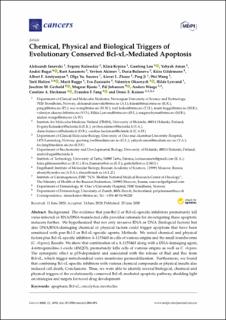| dc.contributor.author | Ianevski, Aleksandr | |
| dc.contributor.author | Kulesskiy, Evgeny | |
| dc.contributor.author | Krpina, Klara | |
| dc.contributor.author | Lou, Guofeng | |
| dc.contributor.author | Aman, Yahyah | |
| dc.contributor.author | Bugai, Andrii | |
| dc.contributor.author | Aasumets, Koit | |
| dc.contributor.author | Akimov, Yevhen | |
| dc.contributor.author | Bulanova, Daria | |
| dc.contributor.author | Gildemann, Kiira | |
| dc.contributor.author | Arutyunyan, Albert F. | |
| dc.contributor.author | Susova, Olga Yu. | |
| dc.contributor.author | Zhuze, Alexei L. | |
| dc.contributor.author | Ji, Ping | |
| dc.contributor.author | Wang, Wei | |
| dc.contributor.author | Holien, Toril | |
| dc.contributor.author | Bugge, Marit | |
| dc.contributor.author | Zusinaite, Eva | |
| dc.contributor.author | Oksenych, Valentyn | |
| dc.contributor.author | Lysvand, Hilde | |
| dc.contributor.author | Gerhold, Joachim M. | |
| dc.contributor.author | Bjørås, Magnar | |
| dc.contributor.author | Johansen, Pål | |
| dc.contributor.author | Waage, Anders | |
| dc.contributor.author | Heckman, Caroline A. | |
| dc.contributor.author | Fang, Evandro Fei | |
| dc.contributor.author | Kainov, Denis | |
| dc.date.accessioned | 2021-02-08T09:38:01Z | |
| dc.date.available | 2021-02-08T09:38:01Z | |
| dc.date.created | 2020-07-22T14:32:31Z | |
| dc.date.issued | 2020 | |
| dc.identifier.citation | Cancers. 2020, 12 (6), 1-19. | en_US |
| dc.identifier.issn | 2072-6694 | |
| dc.identifier.uri | https://hdl.handle.net/11250/2726557 | |
| dc.description.abstract | Background: The evidence that pan-Bcl-2 or Bcl-xL-specific inhibitors prematurely kill virus-infected or RNA/DNA-transfected cells provides rationale for investigating these apoptotic inducers further. We hypothesized that not only invasive RNA or DNA (biological factors) but also DNA/RNA-damaging chemical or physical factors could trigger apoptosis that have been sensitized with pan-Bcl-2 or Bcl-xL-specific agents; Methods: We tested chemical and physical factors plus Bcl-xL-specific inhibitor A-1155463 in cells of various origins and the small roundworms (C. elegans); Results: We show that combination of a A-1155463 along with a DNA-damaging agent, 4-nitroquinoline-1-oxide (4NQO), prematurely kills cells of various origins as well as C. elegans. The synergistic effect is p53-dependent and associated with the release of Bad and Bax from Bcl-xL, which trigger mitochondrial outer membrane permeabilization. Furthermore, we found that combining Bcl-xL-specific inhibitors with various chemical compounds or physical insults also induced cell death; Conclusions: Thus, we were able to identify several biological, chemical and physical triggers of the evolutionarily conserved Bcl-xL-mediated apoptotic pathway, shedding light on strategies and targets for novel drug development. | en_US |
| dc.language.iso | eng | en_US |
| dc.publisher | MDPI | en_US |
| dc.rights | Navngivelse 4.0 Internasjonal | * |
| dc.rights.uri | http://creativecommons.org/licenses/by/4.0/deed.no | * |
| dc.title | Chemical, Physical and Biological Triggers of Evolutionary Sonserved Bcl-xL-Mediated Apoptosis | en_US |
| dc.type | Journal article | en_US |
| dc.type | Peer reviewed | en_US |
| dc.description.version | publishedVersion | en_US |
| dc.source.pagenumber | 1-19 | en_US |
| dc.source.volume | 12 | en_US |
| dc.source.journal | Cancers | en_US |
| dc.source.issue | 6 | en_US |
| dc.identifier.doi | 10.3390/cancers12061694 | |
| dc.identifier.cristin | 1820197 | |
| cristin.ispublished | true | |
| cristin.fulltext | original | |
| cristin.qualitycode | 1 | |

